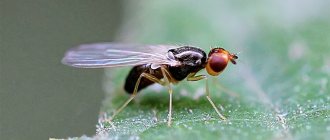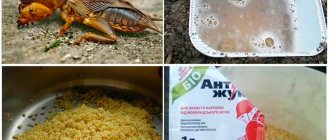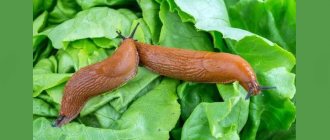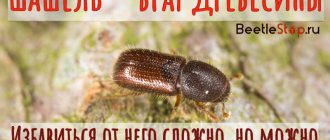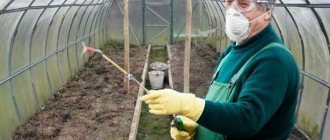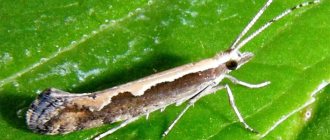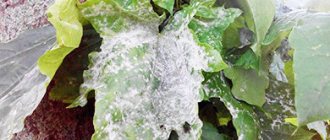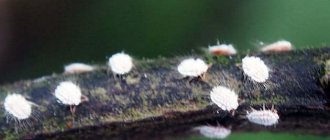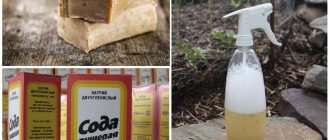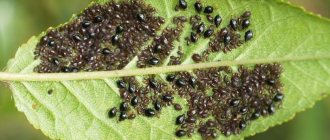The raspberry fly and the fight against it are of interest to many gardeners, because this small pest can cause significant harm to the harvest of tasty and healthy berries. In the spring, it lays larvae inside the raspberry stems, as a result of which they begin to wither, dry out and die.
It is for this reason that the crimson stem fly should be combated at the first signs of its presence in the garden plot. This insect is externally difficult to distinguish from midges. The size of the body does not exceed 8 mm, the wings are transparent, and on the side of the head you can see brown spots resembling large eyes.
The stem fly flies out of the soil in the second half of spring, where its larvae overwinter. When the soil at a burial depth (8–9 cm) warms to +14 °C, they pupate and after 7 days they transform into adult insects. The duration of the emergence of pests lasts 7-8 days, and if the weather is cool and rainy, it is extended to 25 days.
Raspberry pests eat flower nectar, sticky secretions of aphids and other insects. Damage to garden plants is caused by fly larvae. Each pest lays one egg per branch. Even young stems that grow from the soil in a given year (regrowth) are damaged. The egg is attached on the upper part, in the leaf axils.
After 6-7 days, a grayish worm with a beige head without legs hatches from the egg. It bites into the branch and eats away its core. First of all, the upper part of the stem sags, because nutrients and water stop flowing to it. Having emerged from the egg, the larva gnaws holes in the fruit branches, moving towards the base of the green stem.
The development cycle ends with the fly emerging from the shoot, burrowing into the surface layer of garden soil, pupating and remaining to hibernate until warmer weather sets in. Over the course of one season, a generation of pests changes.
Raspberry fly larvae form burrows from top to bottom, along the entire branch
Harm from the raspberry fly
If the upper part of young branches suddenly withers and turns black, and their growth stops, it means that the garden area is attacked by a stem fly. As is known, ordinary raspberry varieties begin to bear fruit on the branches of the second year, and in remontant varieties the fruits are laid on the fruit stems of the first year.
Therefore, raspberry yield indicators directly depend on the number of young shoots formed by the bush in the spring. It is easy to make sure that there is a parasite inside the branch; to do this, you need to examine its cross section: the larvae form burrows from top to bottom, along the entire branch.
If you cut it lengthwise, you can see the worm itself: a small white insect, up to 6 mm in size. In this way, by eating young shoots, raspberry flies are able to almost halve the number of fruitful branches.
Reviews and advice from gardeners
It lasts for many years, but very weakly, so I simply cut off the dead stems. This year the attack was quite serious; in a week more than 1/2 of the young shoots died.
Sources
- https://beetlestop.ru/malinnaya-muha/
- https://zoolog.guru/drugaya-poleznaya-informacia/malinovaya-muha-borba-s-ney.html
- https://ofazende.ru/kak-borotsya-s-malinnoj-steblevoj-muhoj
- https://OgoOgorod.ru/sad/malina/malinovaya-muha.html
- https://rci76.ru/muhi-i-moshki/malinnaya-steblevaya-muha.html
- https://urozhajnayagryadka.ru/malinovaya-muha-foto-vred-posledstviya-kak-borot-sya/
- https://apest.ru/muhi/kak-izbavitsya-ot-muh/malinovaya-muha/
- https://jivovred.com/vsadu/malinovaya-muha-metody-borby
- https://vreditel-stoi.ru/sad/malina/malinnaya-muha.html
- https://qlumba.com/bolezni-rastenii/1227-vse-metody-borby-s-malinnoj-steblevoj-muhoj
- https://septik.guru/polezno-znat/malinovaya-muha-borba-s-ney.html
[collapse]
The main reasons for the appearance of the pest
The cause of the appearance of flies can be the following errors in care or mistakes when planting crops:
- The fly is a pest that also attacks blackberries, meadowsweet, meadowsweet and some other fruit bushes. Therefore, planting raspberries close to blackberry thickets or next to neighboring raspberry fields is a bad idea;
- the raspberry fly can be attracted by a significant number of aphids, which secrete a sweet liquid;
- Shrubs are vulnerable to summer residents who do not carry out preventive spraying against pests in the spring months, during the bud formation phase. This becomes especially important during years of mass fly breeding (due to favorable weather conditions);
- the fly overwinters in the surface layers of humus, which should be dug up to get rid of the pest. In dense raspberry fields this is a rather labor-intensive task, so it is most vulnerable to parasites;
- the pest can enter the garden with low-quality humus, which is used to mulch the soil under raspberry bushes.
The raspberry stem fly can destroy not only raspberry plantations, but also blackberry, meadowsweet and meadowsweet bushes. To avoid mass destruction of raspberries, it is necessary to fight by choosing truly highly effective methods and technologies.
The most attractive to flies are dense plantings, as well as plants weakened by frost or improper care. It is not difficult to fight insects, but you need to prevent massive damage to the planting
How to care for raspberries: top simple rules
If the plant is strong and healthy, it will be able to resist pests and diseases. How to properly care for raspberries:
| Landing To prevent raspberry bushes from getting sick, you need to plant them correctly. The distance between rows should be at least 1.5 meters, and between bushes in a row - at least 70 cm. It is also important to choose good planting material so as not to bring diseases to the site along with it. |
| Trimming In spring, raspberries produce many useless shoots. To increase productivity, you need to trim unnecessary branches every year. In early spring, trim the trunk to a height of 1.5 m and leave no more than 7 large, strong and fruit-bearing branches, so the berries will be much sweeter |
| Loosening and weeding Pest eggs can overwinter in old weeds and underground, so it is important to periodically loosen the soil under the raspberries to a depth of 6 cm and weed out the weeds, this will destroy the pest eggs |
| Watering Raspberries do not like drought, but excess water causes even more harm to them. In summer and spring, raspberry bushes need to be watered as needed, when the ground is completely dry, but in the fall, on the contrary, they need to be heavily watered to prepare for winter. |
| Top dressing It is important to feed raspberries on time so that they grow strong. How to feed raspberries:
Do not use fresh manure for feeding, as it may cause fungal root diseases. At the beginning of summer, you can spray raspberries with Bordeaux mixture to avoid insects |
For more information on how to properly care for raspberries, watch the video:
Control methods depending on the stage of pest development
Throughout the season, the pest goes through several development phases, each with its own control methods. They must be carried out in a timely manner, because what deals a fatal blow to flies is completely harmless to the larvae and vice versa.
| Season | Early spring and autumn, when the air temperature is below +10 °C | Late spring, when the soil warms up to +12 °C | Early summer, before the raspberry blossom phase | Summer to autumn |
| Raspberry fly development phase | Larvae in a state of hibernation | Larvae pupate and flies appear | Flies lay eggs | The larvae emerge, bite into the shoots, and feed on their internal tissues. |
| Fighting methods | Loosening to a depth of 6–8 cm with turning over lumps of earth so that the larvae freeze or are eaten by birds; mulching with a layer of 8–9 cm so that pests cannot fly through this layer | Treatment of shrubs with insecticidal agents; setting traps | Treatment with insecticidal agents against flies and preparations against young larvae; use of fly traps | Treatment with insecticides; shortening branches to healthy parts |
Comprehensive care measures and proper treatment with a variety of insecticidal and preventive drugs are highly effective measures to combat raspberry parasites. Remember that spraying with any industrial solutions is carried out exclusively in calm weather, in the morning or evening, as well as during the day in cloudy weather. This is necessary in order not to cause sunburn on immature fruit bushes.
Characteristic
As you can see in the photo, the raspberry, or stem, fly is a small insect with a pubescent body and a pair of transparent wings. The dimensions are insignificant - the body length of an adult does not exceed 7 mm. The larva is a worm-like caterpillar, with a pale off-white body color, the size of which is about 5 mm. The larva has no legs; the mouthparts are located between the two anterior segments of the body. The adult caterpillar encloses itself in a barrel-shaped false cocoon that is brown in color. The parasites overwinter in this cocoon, usually in the top layer of soil.
In May, when the substrate in the areas where the larvae are located warms up to +12…13°C, they pupate. Development in the pupa lasts about 7-9 days, after which adult flies emerge, whose years last from 8 to 10 days. In cold and rainy weather, the flight may take a little longer - up to 20 days. Under such conditions, most pupae die.
Emerging mature flies feed on flower nectar, dew and sugar secretions of other pest insects, after which the females lay eggs. They usually place eggs on the tops and in the axils of not yet formed leaves, young shoots and in the root shoots of raspberries.
The fertility of female raspberry stem flies is 60-90 eggs. Development in the egg takes from 5 to 8 days, after which the larvae emerge. Young growth bites into the middle of young stems and makes spiral and ring-like passages. The apical parts of damaged stems gradually wither, turn black and die over time. After 12-16 days, the larvae stop feeding. They gnaw through the stem and use the passages they make to descend into the soil for the winter. There they entangle themselves in a false cocoon and remain until spring.
On a note! The number of raspberry stem fly is limited by many predatory insects, especially ground beetles!
Insecticidal preparations
Industrial preparations are used both for preventive purposes and to destroy emerging pests. It should be remembered that treatment with insecticidal agents is carried out when there is no wind, preferably before sunrise or in the evening when the sun sets. Spraying can be done in the daytime, but when it is cloudy.
These restrictions are necessary so that after spraying, burns from ultraviolet radiation do not appear on young leaves. Of course, such chemicals should not be used before rain. Working solutions of these insecticides are used to treat foliage and shoots against flies and soil under bushes. This will deal a fatal blow to the larvae.
Raspberries are processed when their growth reaches at least 15 mm. The following aggressive methods of control are most effective:
Kinmiks for pests
- Confidor. A low-toxic chemical that impregnates the stems, foliage and root system of shrubs. This is an effective insecticide, it is not washed off by precipitation and guarantees excellent protection against raspberry flies even in the heat. Effectiveness lasts about 15 days, then you need to repeat spraying.
- Spark. The drug has a wide spectrum of effects. It is used to spray leaves on which pests feed. Produced in tablet form. Prepare the working solution taking into account the manufacturer's instructions on the packaging of the chemical product. According to the instructions, one tablet is enough to prepare 12 liters of working solution. The raspberry bush is sprayed with it, the leaves and soil are generously moistened.
- Actellik. It is available for sale in the form of ampoules, suspensions, and also in tanks. How to make and use the solution is described in the manufacturer's instructions. Raspberry pest control is carried out no more than twice a year. The chemical has a high level of toxicity.
- Karbofos. It has a moderate level of toxicity. A bucket of water will require 60 g of product. Treat the bushes with the solution. Spraying is carried out in the evening hours when the air temperature drops. The frequency of spraying is about twice throughout the year.
- Fufanon-nova is an effective systemic insecticidal agent. For a solution according to the instructions, one ampoule is dissolved in 5.5 liters of clean water.
Important! The use of the above products is allowed strictly after harvesting. The drugs are dangerous for bees and insects that pollinate raspberries. Do not process if there are beehives in the immediate vicinity.
Means to combat raspberry fly
Prevention
As you can see, the raspberry fly is very dangerous, and the fight against it can take a long time. And in order to avoid troubles and prevent re-infection, it is necessary to act competently throughout the season. The quantity and quality of the harvest will depend on this.
Prevention is quite simple:
- regularly inspect the bushes in your raspberry patch and pay special attention to the condition of young shoots;
- if you know that there is definitely a raspberry fly in the neighboring area, then it would be useful to carry out preventive treatment with the drug “Karbofos” or “Actellik”;
- in spring and autumn, dig up the area and immediately collect all plant debris;
- Before winter, it is advisable to hill up all the bushes and cover the soil around them with mulch from compost or peat.
Remember, if you follow all precautions throughout the season, you can protect your raspberry tree from pest attack. And even if an infection occurs, do not give up, because now you know the methods of combating the raspberry stem fly. They are effective and easy to implement.
Biological drugs
To combat the raspberry fly, effective and safe biological preparations can be used. Fitoverm - the drug acts on a large number of flying insects. The effect occurs if the drug enters the gastrointestinal tract of the insect, but does not affect the larvae and pupae, since they do not feed. This product is safe for bees.
Agravertine is an alcoholic extract of the soil fungus streptomyces. Once in the gastrointestinal tract of an insect, the drug begins to act within 12 hours, paralyzing the insect and causing its death after 3 days. The solution is applied according to the instructions and used immediately after its application. The effect of the drug is especially effective in hot weather.
The harmfulness of the weevil
Damage to strawberry and raspberry plantations is caused by both adult beetles and their larvae. At
In this case, the feeding of adult beetles on leaves is quite short-term and is not as harmful to plants as the destruction of buds during oviposition, which continues from the moment the strawberry buds appear until the appearance of raspberry berries.
The beetle causes enormous damage to early varieties of strawberries. This is due to the fact that pests destroy the first buds in them, from which the largest berries ripen. In later varieties, buds of the 2nd and 3rd order, which are not so important, are affected. Plants with a female type of flower are less affected, since their stamens are underdeveloped and provide less food for the larvae. On the other hand, weevils cause more damage to older plantations.
Folk remedies
The raspberry fly is a specific insect. Preparations prepared by yourself have practically no effect on it. But gardeners and gardeners are not discouraged and are constantly looking for new measures to combat this pest, which can destroy the raspberry crop.
Pest control should begin in early spring. After all, if we prevent the raspberry flies from flying out, then there will be no larvae on the bushes, which means that the shoots will remain intact, and we will harvest from them. It is useless to treat with insecticides before the onset of heat; the insects are not yet feeding, but you can create unbearable conditions for the larvae in the ground.
In the comments, people write that they use Bordeaux mixture for this purpose. It is a mixture of copper sulfate and milk of lime. It is recommended to water the soil under the raspberry bushes with the resulting composition and problems such as raspberry flies will not arise.
Gardeners who have already encountered the raspberry fly in their plots in the summer recommend sprinkling the ground with ash, ground pepper, dry mustard, and mineral fertilizers during the first spring loosening. All these means create an aggressive environment in which the delicate covers of larvae and pupae will be destroyed, which will lead to their death.
Proper and timely care of raspberries will prevent larvae from laying in the stems and will prevent larvae from developing in the soil. What is raspberry care?
- As soon as the first shoots begin to appear, inspect the raspberry tree once a week. When you see wilted young shoots, you must immediately cut them out and be sure to burn them. Cut the stem at ground level and even a little deeper into the ground;
- To prevent the raspberry fly from laying eggs, it is necessary that the larvae do not hatch into adults in the spring. For this purpose, mulching is carried out with a layer of at least 8 cm. Plant residues, peat, and sawdust are used as mulch;
- Remove old branches and young weak growth in a timely manner. They take on useful substances, the return from them will be minimal. The remaining young stems will take up more nutrients, grow stronger faster and cope better with pests and diseases. In addition, thickened raspberries are an ideal environment for flies;
- Treat raspberries in advance with folk remedies and biological preparations, they are harmless and effective, act on other pests, but are safe for bees;
- We fight flies with a solution of baking soda (2 tablespoons per bucket of water) and irrigate before the berries begin to set. For this purpose, someone sprays the bushes with mustard solution, which also helps;
- In the fall, after harvesting, collect fallen leaves, loosen the soil under the bushes; in loose soil, the pupae will freeze faster in winter. Loosen the soil carefully so as not to damage the root system.
- Pour 10 g of birch tar and 30 g of liquid soap, preferably special for plants - green, potassium, into a glass of water. Mix everything well and add water to 10 liters. Thoroughly spray each raspberry leaf and the soil underneath.
You can treat the soil with some insecticide. Don’t forget to feed the bushes in the spring, then in the summer they will delight you with a bountiful harvest of sweet berries
The sequence of measures to protect raspberries
Once the raspberry stem fly appears, it is necessary to fight it for a long time, both in spring and summer, and in autumn. The general plan of events is as follows:
- in early spring, as soon as the snow has melted, you should carefully dig up the entire area and thoroughly loosen the soil under the raspberry bushes;
- at the end of spring - around May, when the mass emergence of flies begins, if the drug allows (remember about the toxicity for pollinating insects), we treat with an insecticide;
- during the budding period, we cut out damaged stems and dispose of them immediately;
- in the fall, after harvesting, we again dig up the soil around the bushes, spill it with Bordeaux mixture and, if necessary, repeat the insecticidal treatment. During this period, it is better to use Karbofos.
Traps for raspberry flies
The fight will be more effective if you also hang traps for garden pests. In stores and departments for summer residents you can find various devices, for example:
- “Evil TED” from LETTO;
- flying insect killer GH1M;
- garden adhesive tape under various brands.
Read the instructions on how to use them. You can make your own traps. Hang plastic bottles with slotted windows on trellises among the raspberry bushes. Pour any sugar-containing liquid inside: fruit drink, beer, syrup, juice. It’s not scary if it ferments; the stronger the sweet smell, the more attractive it is to insects.
What to process
Treatment is carried out both with chemicals (urea, copper sulfate, dolomite flour, Bordeaux mixture) and folk remedies (mustard, soda, boiling water, infusions of herbs and flowers).
To strengthen the plants, treatment with urea is carried out in early spring. Take 15-20 grams per square meter. Urea saturates the bushes with nitrogen and makes them less susceptible to disease.
Treating raspberries with copper sulfate helps avoid the appearance of fungal diseases (gray rot, anthracnose). The raspberry stems and the soil around the bushes are processed. For spraying, take 50 grams of vitriol per 5 liters of water.
When fighting anthracnose, rust and powdery mildew, treating bushes with a 1% solution of Bordeaux mixture or iron sulfate, Topaz, Nitrofen helps.
The main reasons for the development of infections are high humidity and high acidity of the soil. Reducing watering reduces humidity. Acidity can be reduced using wood ash, slaked lime, and dolomite flour. Take 150 grams per square meter.
Mustard protects raspberries from weevil larvae.
Instead of mustard, you can take baking soda, dilute 2 tablespoons in 10 liters of water.
Treating the bushes and root circle with boiling water allows you to get rid of most pests. The procedure is carried out after the snow has melted and the soil has warmed up.
If the affected area is small, raspberry beetle larvae can be collected manually. Before flowering, the plant is treated with an infusion of wormwood and marigold. When using Agravertine and Agravertine, the treatment is carried out twice.
During budding, raspberries can be sprayed with tansy infusion.
For the infusion, take 350 grams of dry herbs or a kilogram of freshly harvested raw materials, 5 liters of water. The tansy is infused for a day, then boiled for half an hour, filtered and diluted with the same amount of water.
Mulching with pine needles protects against weevils and gray rot.
The main diseases of raspberries and methods of combating them
No less than pests, various diseases can plague raspberries. It’s hard to say which of these two misfortunes could harm her more. One way or another, you need to deal with them in time, and thanks to the information below, you will be able to identify raspberry diseases and their treatment will not be a problem for you.
Anthracnose
An insidious disease that can affect all parts of the plant. It all starts with brown spots that have a dark edge. Gradually they increase and fill the entire space of the sheet. In the future, cracks appear in these places, and in damp weather, rot can develop.
There may be several reasons for the occurrence of anthracnose, but one of the main ones is a lack of phosphorus and potassium. The development of the disease begins in warm and humid weather, so if it rains frequently, then for prevention it is worth treating with fungicides.
Purple spot
It is very easy to identify the disease by the presence of small purple spots on young shoots. Very quickly they grow in diameter and occupy most of the leaf. As a result of this disease, the bushes are greatly weakened, may not survive winter well and become more vulnerable to other diseases.
Treatment with a fungicide gives good results in the fight against purple spot. Before flowering, young shoots are treated with topaz or any other broad-spectrum systemic agent.
Before purchasing and planting new seedlings, pay attention to their leaves. If the aerial part is damaged, it is cut off and only the rhizome is used for planting.
White spot
The presence of the disease is indicated by small brown and then white spots. They appear on leaves and stems, after which they become covered with black spores. They have a depressing effect on bush growth.
Preventive control measures include moderate watering and sparse planting (it is important to provide ventilation to the shoots). In autumn and spring, plantings are treated with copper sulfate, and if a disease occurs, with a contact fungicide
Canker spot of stems
The disease manifests itself as irregularly shaped brownish spots that appear on growing stems. Over time, they become gray and form small depressions in which cracks appear. Black spores can be observed on the surface.
The affected bushes are treated with Bordeaux mixture (1%), and in case of mass damage, with a stronger fungicide. After harvesting, the yield concentration can be increased.
Bacterial root cancer
A dangerous disease that can only be detected when replanting bushes. As a result of bacterial damage to the roots, massive growths appear on them. Shoot growth slows down and yields decrease.
There is no cure for bacterial cancer. All affected shoots are removed and burned, and healthy ones are transplanted to a new place, adding a generous dose of mineral fertilizers.
Mosaic
A dangerous viral disease that appears as yellow-green spots on the leaves. It spreads quite quickly. Plants look weakened and depressed.
It is difficult to treat, so heavily affected bushes must be mercilessly uprooted. Do not get carried away with nitrogen fertilizers and do not neglect the autumn and spring treatment of bushes with copper sulfate.
Curly
This disease can be identified by the appearance of the root shoots: it has a thickened stem and curled leaves. In addition, the leaves become smaller and acquire a bronze tint.
If measures are not taken in time, the infected raspberry tree will die in a few years. It is almost impossible to cure curling with drugs, so plants with signs of the disease are removed and burned.
Preventive measures
Experienced gardeners know how difficult it is sometimes to remove some pests from a plot. In order not to resort to the frequent use of chemical, aggressive agents that can poison the soil, and in order to produce environmentally friendly berries, it is advisable to follow the basic rules of cultivation from the moment of planting the raspberry tree and throughout its entire life cycle. They include:
- When purchasing cuttings, you must carefully examine their root part and buds so as not to introduce insect larvae into the area;
- a year before planting, sow mustard, clover, and rye on the territory of the future raspberry field. Green manure can be sown between rows during the growing process. These plants nourish the soil with nitrogen fertilizers, loosen it, and most importantly, repel all kinds of pests;
- do not plant new varieties of raspberries in the area where they previously grew: potatoes, tomatoes, eggplants, strawberries, wild strawberries - crops affected by the same pests as raspberries;
- regularly and promptly cut and destroy affected branches, berry clusters, leaves;
- regularly pull out weeds on which insects and larvae remain overwintering;
- Apply fresh manure to the raspberry garden only in the fall. The larvae of insects and parasites must have time to die from frost and rotting fertilizer.
In many modern raspberry varieties, resistance against pests is genetically determined. Remontant varieties are also rarely attacked by uninvited guests, since most often gardeners remove the entire above-ground part of the bush, along with insects and larvae, before winter. But for the prevention and control of pests of simple raspberries, compliance with the simple but important conditions given above is required. Compliance with them will preserve the harvest, as well as the health of not only raspberries, but also many other plants on the site. After all, pests not only themselves infect shoots, leaves and berries, they are carriers of many diseases.
Appearance of an insect
The raspberry stem fly is a small insect, about 6-7 mm long. Their color is brown-gray. The raspberry fly winters under bushes - in the upper layers of the soil. The active breeding season of the pest begins in the spring and occurs in April and May, depending on the regions of the country. This happens during the period when young shoots begin to appear. A raspberry fly crawls out of the ground.
To recognize the pest, you should carefully look at the photo of the raspberry stem fly. By itself, it is harmless; problems begin after it lays white, oval-shaped microscopic eggs. In total, a raspberry fly is capable of laying 90 of them. As soon as this happens, changes in the plant become noticeable - gradual withering of the leaves begins.
Insects lay eggs in the axils of the upper parts of the leaves. After 5-8 days, larvae are born, having a cylindrical shape and a white color. It is they, and not white flies on raspberries, as people often say, that cause significant damage to the bushes, gnawing helical passages in the soft stems. As a result, the bases of young shoots are damaged. Recognizing a raspberry fly is quite simple. If the young shoots in the upper part of the bush become sluggish and turn black, this means that a raspberry fly has appeared. There are passages visible along the stems, and if you cut them, you can see the larva itself. If no action is taken, the plant will die or the number of young shoots that are fruitful will be greatly reduced.
The raspberry stem fly can destroy not only raspberries, but also blackberries, meadowsweet and meadowsweet. To avoid mass destruction of bushes, you should fight by choosing truly effective methods and methods.
